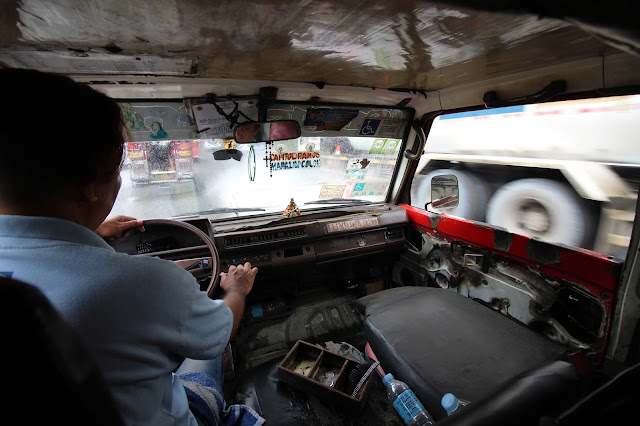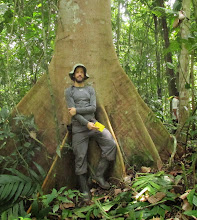One of the fundamental joys of travel derives from the simple act of moving forward, by whatever means, towards the great unknown. In honour of this most basic travel element, which brings me wonder, curiosity and a sense of awareness while entering new lands, I dedicate the first post of my new blog to the thrifty joy of public transit in the Philippines, and the revelations it brings.
If it works for you as it did for us, you'll jump on to public transit to find a memorable travel experience alongside locals who are incredible friendly and curious. Traveling with the locals is an immersive experience. It’s your chance to meet people and observe diversity and customs within the local people. In the Philippines, most people do not own cars and instead use public transport, so you'll see everyone including: young families, old friends, farmers with their rooster, peanut roasters -- the whole world comes together on public transit!
Furthermore, public transit is a sure way to save a few bucks as a ride in public transit can be a small fraction of the cost of guided tours, tourist buses, and local flights. I write this blog partly with the goal to encourage travelers to pursue genuine experiences on public transport. I know it seems a little crazy but don’t be afraid to step a little out of their comfort zone as in most cases you’ll quickly adapt and then can sit back and enjoy the ride.
A few typical travel modes while in the Philippines:
You are not in the Philippines until you’ve ridden a jeepney!
The jeepney, a vehicle transport originating after WWII from the refurbishment of US military jeeps left behind in the Philippines, is a mode of transport unique to the Philippines. During postwar recovery from 3 years of Japanese occupation, the US military jeeps were adapted opportunistically by cutting them in half, and extending their cab so as to transport as many people as possible.
The jeepney, a vehicle transport originating after WWII from the refurbishment of US military jeeps left behind in the Philippines, is a mode of transport unique to the Philippines. During postwar recovery from 3 years of Japanese occupation, the US military jeeps were adapted opportunistically by cutting them in half, and extending their cab so as to transport as many people as possible.
 |
| Broke down jeepney on the streets of Cebu City. |
Today, the jeepney vehicle is a smoke-belching, but often beautifully decorated, ubiquitous hallmark of the Philippine roadways. They are as common as coconut trees on the country's white sand beaches. Although modern jeepneys are made from converted second-hand cargo trucks, the cultural legacy of their post-war origin persists. While the jeepneys can be intimidatingly crowded (warning - maybe not a good idea if carrying all your luggage) they have a fixed cost usually around $0.20 for a ride whether a short distance or all the way across town. At that price, I highly encourage you to try this unique transport out! Our first ride in one through the streets of Cebu city was just plain fun.
A local tricycle
Next up, try riding a tricycle
Seems silly, right? But this very common transport - a motorcycle welded to some form of rebar personal carrier, which is balanced upon a third wheel - is serious business for covering local distances in the Philippines. Rides in some towns will cost about $0.25 each, whereas a ride connecting towns might run a few dollars. Although, they seem daunting at first, tricycles (as they are called) are extremely useful and quite easy with or without your luggage. Nonetheless, hang on tight, these ‘tricycles’ are no toys - some of them can really rip!
 |
| Blissful 5 hour ferry ride from Ubay, Bohol to Cebu City, Cebu Photot by Flora Hugon |
Island hopping by ferry
The Philippines comprise over 7,000 islands so chances are you will likely be boarding a boat at some point. Privately-run ferries seem to connect just about every major island you might want to go to and are very affordable. I have some good news and some bad news. The bad news is that some ferries are a bit dodgy for sailing in the sometimes rough seas. Check the weather and have a look at the boat before jumping aboard. Use your common sense. The good news, is that you can buy beer on most ferry rides for less than a buck, and many boats have beds for seating. Go on a sunny day, kick back and enjoy the ride! An added bonus is that fuel consumption by these boats is far less than island hopping by airplane, which means that not only will you sail the high seas with cold beers in hand but you will be treading lightly on Mother Earth as you do so.
 |
| We declined a taxi driver's offer to take us Cebu City to Moalboal for 1500 pesos, and instead caught the bus for 106 pesos each. |
Our experience with the public bus was terrific. There was always a bus coming along on major routes on Cebu and Bohol within fifteen minutes of waiting. They will pick you up anywhere and cost usually no more than $2-3 for a ride of a couple hours. Have no fear; the buses were extremely convenient and plain simple to ride.
A backpacker’s jeepney revelation
Many things in the Philippines are very cheap, but tours set up for foreigners we often found to be comparatively expensive. And while people were generally extremely friendly we were charged a bit more sometimes because of the fact that we were tourists. While I think it is important to support tourism operators with your tourist dollar -- tourism is almost 8% of GDP in the Philippines -- my travel philosophy dictates to avoid being unfairly overcharged and to spread my money amongst as many people as possible (preferably to people who really need it) rather than concentrate it into the hands' of a few tour operators. Watch out: some tourism operators have developed specialized skills to get tourists to pay. I've experienced this many times in different parts of the world and it happened again on our second day in Cebu City.
This is what happened: we hired a driver to take us on a tour. A misunderstanding became apparent halfway to our destination: his price for our tour had increased by a factor of five (ie. He was suddenly quoting us $250 USD). This may have been a misunderstanding but after we changed our itinerary (eg, cancelled the boat trip, lunch, and snorkelling) and instead simply arranged (very clearly, now) a price to use him as a taxi service to bring us to a restaurant he again later doubled his price. We argued but eventually submitted. In the end, we paid him $75 CAD for a $2 jeepney ride...
This is what happened: we hired a driver to take us on a tour. A misunderstanding became apparent halfway to our destination: his price for our tour had increased by a factor of five (ie. He was suddenly quoting us $250 USD). This may have been a misunderstanding but after we changed our itinerary (eg, cancelled the boat trip, lunch, and snorkelling) and instead simply arranged (very clearly, now) a price to use him as a taxi service to bring us to a restaurant he again later doubled his price. We argued but eventually submitted. In the end, we paid him $75 CAD for a $2 jeepney ride...
Fortunately, we knew better than to have a bad taste left in our mouth from that experience. People of the Philippines are some of the kindest people of any country I have visited! He was a one off, and it reminded me, once again, that travelling with the locals is not only fun but it results in a more balanced exposure to the actual people of the country.
Side bonus, not only did we have a memorable and photogenic ride in the back of the jeepney but we were riding a deep historical context of the Philippines. When in the Philippines (and other places) my seasoned traveler perspective encourages you step a little out of your comfort zone and travel with the locals. locals via unique modes of travel!




